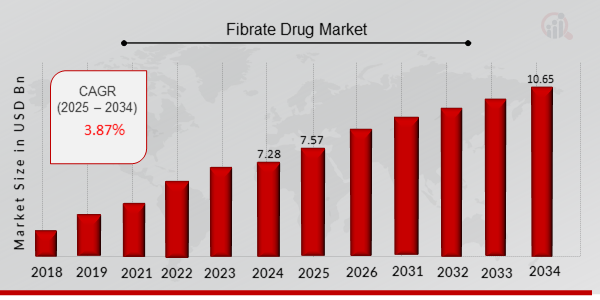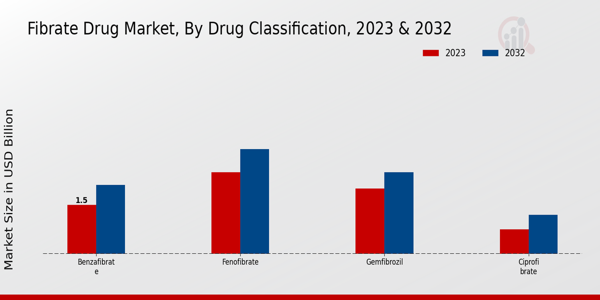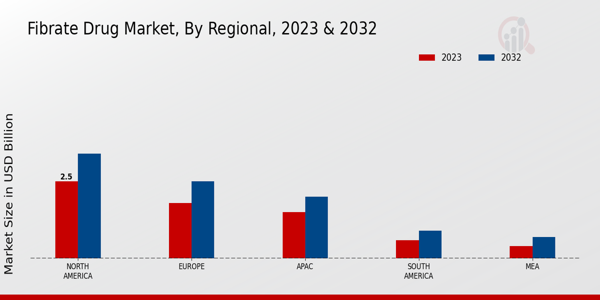Fibrate Drug Market Overview
As per MRFR analysis, the Fibrate Drug Market Size was estimated at 7.28 (USD Billion) in 2024. The Fibrate Drug Market Industry is expected to grow from 7.57 (USD Billion) in 2025 to 10.65 (USD Billion) till 2034, at a CAGR (growth rate) is expected to be around 3.87% during the forecast period (2025 - 2034).
Key Fibrate Drug Market Trends Highlighted
The Fibrate Drug Market is witnessing significant growth driven by the increasing prevalence of dyslipidemia and cardiovascular diseases. Awareness about the importance of lipid-lowering therapies among clinicians and patients has fueled demand for fibrates. Additionally, aging populations are more susceptible to metabolic disorders, further propelling the market. The rise of lifestyle-related conditions, notably obesity and diabetes, has also led to a higher incidence of hyperlipidemia, prompting a greater utilization of fibrates for managing cholesterol levels. Opportunities within the market are extensive, particularly in developing regions where healthcare access is improving.Increased investment in healthcare infrastructure, along with a rising middle class, is likely to enhance the availability and affordability of fibrate medications. Collaborations between pharmaceutical companies and healthcare providers to educate patients about the benefits of these drugs present a favorable avenue for growth. Furthermore, the ongoing research and development initiatives aimed at improving the efficacy and safety profile of existing fibrate drugs could lead to the introduction of novel therapies. Recent trends in the market indicate a shift towards combination therapies that include fibrates as part of a broader strategy for managing cholesterol levels.The emergence of personalized medicine aligns well with fibrate treatments, as tailored therapies have shown promising results in improving patient adherence and outcomes. Additionally, digital health solutions and telemedicine are gaining traction, making it easier for patients to receive consultations and prescriptions for fibrate medications. The integration of technology in healthcare is helping to streamline treatment processes and enhance patient engagement, which could further drive the growth of the market. Overall, the Fibrate Drug Market presents a dynamic landscape characterized by evolving healthcare needs and innovative approaches to treatment.

Source: Primary Research, Secondary Research, MRFR Database and Analyst Review
Fibrate Drug Market Drivers
Increasing Prevalence of Hyperlipidemia
The Fibrate Drug Market industry is experiencing significant growth due to the rising prevalence of hyperlipidemia and related cardiovascular diseases. With changing lifestyles and dietary habits, there has been a notable increase in the population diagnosed with high cholesterol levels. This condition is a major risk factor for developing serious health issues such as heart attacks, strokes, and other cardiovascular ailments. Fibrate drugs play a crucial role in managing and treating hyperlipidemia by effectively lowering cholesterol and triglyceride levels in the bloodstream.The growing awareness among healthcare professionals and patients about the benefits of fibrate therapy is driving the demand for these drugs. Additionally, as the awareness of preventive healthcare increases, more individuals and healthcare providers are focusing on early intervention strategies to control cholesterol levels, thereby boosting the Fibrate Drug Market. Increasing investments in pharmaceutical research and development also support the enhancement of fibrate medications, leading to improved formulations that are more effective and have fewer side effects.This ongoing focus on reducing cardiovascular risks fuels a strong market progression for fibrate drugs, as they remain a forefront treatment option. The emergence of innovative fibrate formulations and combination therapies further supports market growth as they cater to the evolving demands of patients and healthcare systems. Furthermore, health campaigns and initiatives promoting healthy lifestyles and regular health check-ups contribute to early diagnosis and treatment of hyperlipidemia, thereby reinforcing the market's positive trajectory.
Technological Advancements in Drug Formulation
Technological advancements in drug formulation are significantly impacting the Fibrate Drug Market industry. Newer and more efficient manufacturing processes are being developed, enhancing the bioavailability and therapeutic effectiveness of fibrate medications. The introduction of novel delivery systems, such as sustained-release and targeted-release formulations, allows for better patient adherence and improved treatment outcomes. These innovations not only contribute to patient satisfaction but also serve to foster sustained growth in the market demand for fibrate drugs.As pharmaceutical companies continue to invest in research and development for advanced drug delivery techniques, the efficacy and applicability of fibrates expand, further driving the market.
Growing Aging Population
The global aging population is a significant driver of growth in the Fibrate Drug Market industry. As individuals age, they become more susceptible to chronic diseases, including cardiovascular diseases and dyslipidemia. This demographic segment typically requires long-term medication management, increasing the demand for fibrate drugs to control lipid levels and promote heart health. Moreover, the geriatric population often has multiple comorbidities, necessitating comprehensive treatment regimens that include fibrates.Consequently, healthcare systems and pharmaceutical companies are focusing on developing specialized formulations and treatment strategies tailored to meet the needs of older adults, propelling market growth.
Fibrate Drug Market Segment Insights
Fibrate Drug Market Drug Classification Insights
The Fibrate Drug Market is experiencing notable growth with a projected valuation of 6.75 USD Billion in 2023, expected to rise to 9.5 USD Billion by 2032, highlighting the upward trajectory of this industry. Within the Drug Classification segment, several key categories comprise the market, including Benzafibrate, Fenofibrate, Gemfibrozil, and Ciprofibrate. Benzafibrate holds a significant position, with a market valuation of 1.5 USD Billion in 2023 and an anticipated increase to 2.1 USD Billion by 2032, demonstrating its robust performance and the growing adoption of this drug in managing cholesterol levels.Fenofibrate leads the segment, boasting the highest valuation of 2.5 USD Billion in 2023 and is expected to grow to 3.2 USD Billion, establishing it as a dominant player in the market due to its effectiveness in triglyceride reduction. Gemfibrozil also plays a crucial role, valued at 2.0 USD Billion in 2023 and projected to reach 2.5 USD Billion by 2032, showcasing its vital contribution to addressing lipid abnormalities. Ciprofibrate, while smaller in valuation at 0.75 USD Billion in 2023, is expected to expand to 1.2 USD Billion, reflecting its emerging significance in the treatment landscape.The market dynamics are driven by factors such as rising incidences of cardiovascular diseases, increasing awareness regarding lipid management, and expanding lifestyles that lead to obesity, all contributing to the growing demand for fibrate medications. The segmentation of the Fibrate Drug Market illustrates diverse opportunities, where Fenofibrate dominates due to its proven efficacy and broader acceptance among healthcare professionals, while Benzafibrate remains significant in specific patient populations requiring tailored therapeutic approaches.Gemfibrozil’s competitive position demonstrates its sustained relevance, particularly for patients who respond best to this treatment, while Ciprofibrate has the potential for growth given its lower market footprint yet distinctive therapeutic options. Overall, understanding the nuances within the Drug Classification segment of the Fibrate Drug Market helps in identifying key trends, challenges, and opportunities, ultimately allowing stakeholders to strategize effectively in a continuously evolving healthcare environment.

Source: Primary Research, Secondary Research, MRFR Database and Analyst Review
Fibrate Drug Market Route of Administration Insights
The Route of Administration segment in the Fibrate Drug Market represents a critical aspect of market dynamics, highlighting various methods through which these drugs are delivered to patients. In 2023, the overall market stood at 6.75 USD Billion, reflecting a robust performance driven by the therapeutic efficacy of fibrates in managing dyslipidemia. Among the methods of administration, oral delivery remains a preferred choice due to its convenience and patient compliance, allowing for significant consumption. Intravenous administration plays a vital role in acute settings where rapid action is desired, showcasing its importance in critical care scenarios.Topical formulations are also significant as they offer localized treatment options, minimizing systemic exposure. The segmentation within the route of administration underscores diverse approaches to treatment, catering to patient needs and preferences and contributing to the Fibrate Drug Market revenue. The increasing prevalence of cardiovascular diseases and lifestyle disorders serves as a primary growth driver, while challenges such as regulatory hurdles and market competition may impact future developments. Overall, these routes are pivotal in shaping the landscape of the Fibrate Drug Market industry, providing various options for patient-centric healthcare.
Fibrate Drug Market Therapeutic Area Insights
The Fibrate Drug Market, specifically within the Therapeutic Area segment, is projected to reach a valuation of 6.75 billion USD in 2023, reflecting the increasing demand for treatment options addressing lipid abnormalities. This market is primarily driven by the rising prevalence of conditions such as Hyperlipidemia, which has become a significant health concern impacting millions globally. Cardiovascular Diseases also play a crucial role, as fibrates are often integral in managing dyslipidemia, a key risk factor for cardiovascular events.Meanwhile, in the context of Diabetes Management, fibrates serve as an essential therapeutic category, particularly for patients experiencing lipid abnormalities associated with diabetes. The market is witnessing trends such as an emphasis on combination therapies and increased awareness of preventive care, contributing to steady market growth. However, challenges remain, including regulatory hurdles and competition from alternative therapies. Overall, Fibrate Drug Market statistics reveal a robust landscape, with therapeutic application across various health concerns offering substantial opportunities for growth and innovation within the industry.
Fibrate Drug Market Distribution Channel Insights
The Fibrate Drug Market is set to experience a steady expansion through its Distribution Channel, which plays a vital role in the accessibility and availability of these medications. In 2023, the market reached a valuation of 6.75 USD Billion, with expectations to grow further, demonstrating a stable trajectory. Various channels, such as Hospital Pharmacy, Retail Pharmacy, and Online Pharmacy, contribute significantly to the market. Hospital pharmacies hold a crucial position due to their direct access to healthcare providers, ensuring that patients receive necessary medications during their treatment.Retail pharmacies are also significant, making fibrate drugs readily available to consumers, thus bridging the gap between patients and prescriptions. Online pharmacies have gained traction, particularly in recent years, by offering convenience and expanded access to these medications, meeting the evolving shopping preferences of consumers. This multi-channel approach to distribution not only enhances market growth but also caters to diverse patient needs, raising the overall Fibrate Drug Market revenue. The segmentation underscores the critical role of these distribution channels in ensuring proper patient care and addressing the growing demand for fibrate drugs.
Fibrate Drug Market Regional Insights
The Fibrate Drug Market exhibits diverse regional dynamics, showcasing significant variations in market value and growth potential across various regions. In 2023, North America holds a major share, valued at 2.5 USD Billion, and projected to reach 3.4 USD Billion by 2032, reflecting its dominance in the Fibrate Drug Market due to well-established healthcare infrastructure and high prevalence of cardiovascular diseases. Europe, with a market valuation of 1.8 USD Billion in 2023, anticipated to rise to 2.5 USD Billion in 2032, is experiencing steady growth, driven by increasing awareness and adoption of preventive medication strategies.The APAC region, valued at 1.5 USD Billion in 2023 and expected to hit 2.0 USD Billion by 2032, is significant due to its rapidly expanding healthcare markets and growing population, while South America and MEA, valued at 0.6 USD Billion and 0.4 USD Billion respectively in 2023, indicate potential for growth though currently represent smaller portions of the Fibrate Drug Market. South America is anticipated to see an increase to 0.9 USD Billion in 2032 and MEA to 0.7 USD Billion, highlighting the opportunities for market expansion as healthcare access improves in these regions.Each region is positioned uniquely, with North America leading while others gradually carve their share as health initiatives advance.

Source: Primary Research, Secondary Research, MRFR Database and Analyst Review
Fibrate Drug Market Key Players and Competitive Insights
The Fibrate Drug Market is characterized by a dynamic landscape with several key players navigating through various competitive strategies to capture market share. Fibrates are primarily used to treat hyperlipidemia, and their efficacy in lowering triglycerides and increasing HDL cholesterol levels has made them a preferred choice for many healthcare providers. The market is influenced by factors like the increasing prevalence of metabolic syndrome, the rise in cardiovascular diseases, and the growing demand for lipid-lowering medications. The competition is marked by strategic collaborations, innovative drug formulations, and pricing strategies, which allow companies to differentiate their products and enhance their market position.Pfizer has established a strong presence in the Fibrate Drug Market, leveraging its robust research and development capabilities to innovate and refine its product offerings. The company's commitment to addressing unmet medical needs in the field of lipid management is evident through its development pipelines and an emphasis on clinical trials that demonstrate the effectiveness and safety of its fibrate medications. Pfizer's well-established brand reputation and extensive global distribution networks also contribute to its competitive advantage, allowing the company to reach a broad patient population. Furthermore, partnerships with healthcare providers and participation in educational initiatives fortify Pfizer’s position within the market, ensuring that its products remain at the forefront of healthcare solutions for dyslipidemia.Roche, meanwhile, has made significant inroads into the Fibrate Drug Market through its strong focus on research and innovation, which has positioned the company as a reliable player in the realm of cardiovascular therapies. The company’s dedication to the development of advanced fibrate formulations that enhance therapeutic outcomes is complemented by its rigorous clinical evidence supporting the efficacy of its products. Roche's commitment to quality and safety is reflected in its manufacturing processes that adhere to the highest international standards. Moreover, its strong relationships with the medical community, combined with strategic marketing efforts that highlight the unique benefits of its fibrate offerings, effectively bolster Roche’s market position in this competitive landscape. The company’s ongoing investment in research also ensures that it remains a key contributor to advancements in the treatment of lipid disorders.
Key Companies in the Fibrate Drug Market Include
- Pfizer
- Roche
- Bristol-Myers Squibb
- Eli Lilly
- Takeda
- Johnson and Johnson
- GlaxoSmithKline
- AstraZeneca
- Amgen
- AbbVie
- Merck and Co
- Novartis
- Sanofi
- Boehringer Ingelheim
Fibrate Drug Market Industry Developments
Recent developments in the Fibrate Drug Market indicate a dynamic landscape influenced by ongoing research and market expansions. Companies like Pfizer and Roche have reported advancements in their drug formulations aimed at improving patient outcomes, particularly in managing lipid levels. Current affairs highlight the increasing prescription rates of fibrate drugs as healthcare professionals seek effective treatments for hyperlipidemia. Additionally, Bristol-Myers Squibb and Eli Lilly have been focusing on strategic collaborations to enhance their portfolios in this space. No significant mergers or acquisitions involving the listed companies have been reported recently, but the market valuation for firms such as Takeda, Johnson & Johnson, and GlaxoSmithKline continues to grow due to rising global health awareness and an emphasis on cardiovascular health. AstraZeneca and Amgen are investing in innovative research, positioning themselves to capture larger market shares. Overall, the competitive environment remains robust, with major players actively pursuing research initiatives to tailor fibrate therapies, reflecting the ongoing demand for effective lipid-lowering treatments amidst regulatory and market shifts.
Fibrate Drug Market Segmentation Insights
Fibrate Drug Market Drug Classification Outlook
- Benzafibrate
- Fenofibrate
- Gemfibrozil
- Ciprofibrate
Fibrate Drug Market Route of Administration Outlook
Fibrate Drug Market Therapeutic Area Outlook
- Hyperlipidemia
- Cardiovascular Diseases
- Diabetes Management
Fibrate Drug Market Distribution Channel Outlook
- Hospital Pharmacy
- Retail Pharmacy
- Online Pharmacy
Fibrate Drug Market Regional Outlook
- North America
- Europe
- South America
- Asia Pacific
- Middle East and Africa
| Report Attribute/Metric |
Details |
|
Market Size 2024
|
7.28 (USD Billion)
|
|
Market Size 2025
|
7.57 (USD Billion)
|
|
Market Size 2034
|
10.65 (USD Billion)
|
|
Compound Annual Growth Rate (CAGR)
|
3.87 % (2025 - 2034)
|
|
Report Coverage
|
Revenue Forecast, Competitive Landscape, Growth Factors, and Trends
|
|
Base Year
|
2024
|
|
Market Forecast Period
|
2025 - 2034
|
|
Historical Data
|
2020 - 2024
|
| Market Forecast Units |
USD Billion |
| Key Companies Profiled |
Pfizer, Roche, BristolMyers Squibb, Eli Lilly, Takeda, Johnson and Johnson, GlaxoSmithKline, AstraZeneca, Amgen, AbbVie, Merck and Co, Novartis, Sanofi, Boehringer Ingelheim |
| Segments Covered |
Drug Classification, Route of Administration, Therapeutic Area, Distribution Channel, Regional |
| Key Market Opportunities |
Rising prevalence of dyslipidemia, Increasing geriatric population, Growing demand for combination therapies, Advancements in drug formulation technology, and Expanding healthcare infrastructure in emerging markets. |
| Key Market Dynamics |
Increasing prevalence of dyslipidemia, Rising geriatric population, Growing healthcare expenditure, Expanding pharmaceutical research investments, Emerging markets adoption |
| Countries Covered |
North America, Europe, APAC, South America, MEA |
Frequently Asked Questions (FAQ) :
The Fibrate Drug Market is expected to be valued at 10.65 USD Billion by 2034.
The Fibrate Drug Market is expected to grow at a CAGR of 3.87% from 2025 to 2034.
North America is expected to dominate the market with a projected value of 3.4 USD Billion in 2032.
The Fenofibrate segment is projected to reach a market value of 3.2 USD Billion by 2032.
Key players include Pfizer, Roche, Bristol Myers Squibb, Eli Lilly, and Takeda, among others.
The Gemfibrozil segment is expected to be valued at 2.5 USD Billion in 2032.
The APAC region is projected to reach a market value of 2.0 USD Billion by 2032.
The Benzafibrate segment is anticipated to be valued at 2.1 USD Billion by 2032.
South America is expected to grow to a market value of 0.9 USD Billion by 2032.
Challenges may arise from regulatory changes, market competition, and fluctuating healthcare costs.

















